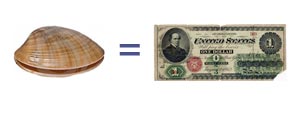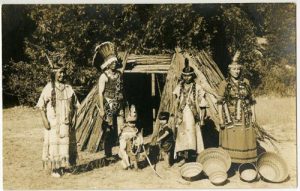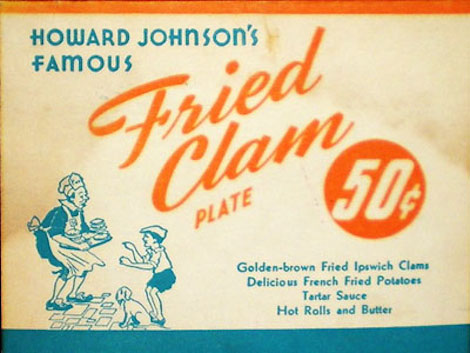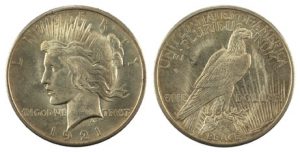When a reader recently requested I look into the origin of clams as a slang synonym for “dollar,” this writer thought sure, easy peasy, lemon squeezy. But it turns out there is very little on the web concerning usage of a bivalve to refer to a single greenback (or buck, smacker, simoleon, or ducat, for that matter), with the main origin theories hardly convincing and references thin.
But here goes. I’ll tell you what I found out, which isn’t much. I’ll then give you my own homegrown, totally unscholarly thoughts on how saltwater mollusks became equated with dollars.

The origin story for clams = dollars that has the most currency – pun alert! – on the web involves the Miwoks, a Native American tribe, and the then-famous but by now mostly-forgotten cultural anthropologist Alfred Louis Kroeber (1876 –1960).

In his work Handbook of Indians of California, published in 1919, Kroeber stated “the Miwok, Ohlone, Patwin, Pomo, and Wappo peoples of central California used the marine bivalve Saxidomus to make shell money.” It is this rarified source that is cited several times on the Internet as the origin of clams to signify U.S. money.

A few other word-sleuthing websites half-heartedly suggest the expression first came from the monetary practices of Polynesian Islanders or even Inuits. Other writers guess that the slang term clams goes all the way back to 16th century Britain, but all these claims are little more than vague assertions, at least as they appear on the web.
This Writer’s Early Experience with Clams both Monetary and Edible

Growing up in the fifties as a grade-school kid in a big Midwest town almost equidistant from either coastline, I distinctly remember hearing and using the plural clams as a substitute for moola even though clams as a food item were almost totally unavailable with the exception of the delicious batter-fried clam strips available at the then-popular Howard Johnson chain of restaurants.
Clams back in the day, was one of those expressions, like jalopy, that was fun to say because it sounded both silly and raffish at the same time. But where did I learn that bit of slang? Not from my parents or their friends — they would have thought the term uncouth. Surely I heard clams used by my playground peers. But where did they first hear that particular usage? From semi-disreputable adults of their acquaintance? From the old black-and-white cartoons appearing on TV on Saturday mornings? From a pre-code Jame Cagney gangster movie? From an Abbott and Costello comedy?
Which gets back to my earlier etymological concerns regarding clams. Missing are the solid, first-appearing-in-print dates and references for the idiomatic use of clams on the web, except for the one scholarly reference by Kroeber mentioned above. Based on the preponderance of non-evidence, I should probably resort to the phrase used by many dictionaries in cases like this – “origin unknown.”

My Hunch
Here is my theory. By the mid-nineteenth century, the United States was abustle with new industry, new commerce, new groups of people, and new slang. At the same time, on the East Coast – New York City for sure – clams were commonly featured on the menus of most eating establishments, from the dive-iest of saloons to the ritziest restaurants.
It is not hard to imagine, after consuming their order of clams on the half shell, patrons saw the empty shells and noted their resemblance – roundish, silverish – to a pile of silver dollars. And if the shells were dropped on a hard surface like a countertop, table, or wooden or tiled floor, they would emit a sound similar to the clatter of falling coins.
Well, that’s my guess as how clams came to be associated with a single unit of American money, backed by no hard evidence at all.
And Now a Digression Regarding Clams

The habitués of a certain eatery for whom it is easy to imagine regularly using the clams idiom. According to Wikipedia, on April 7, 1972 while celebrating his 43rd birthday with family and friends at Umberto’s Clam House, gangster “Crazy” Joey Gallo was shot dead by Sonny Pinto, a mobster and hit man from the Colombo crime family, “and two out-of-town torpedoes known only as Cisco and Benny, who came in through the side door blasting.”
According to news reports, Gallo never got to finish his plate of scungilli with clam sauce. No one was ever charged in his shooting.